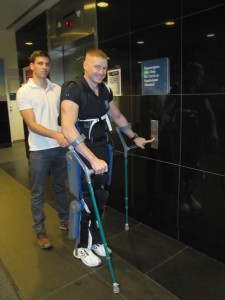“Paralyzed Army veteran Gene Laureano cried when he first walked again with robotic legs at a New York clinic as part of research sponsored by the Department of Veterans Affairs. But when the study ended, so did his ability to walk.
Now he may get the chance to walk everyday: The VA has agreed to pay for the powered exoskeleton for eligible paralyzed veterans with spinal cord injuries — marking the first federal coverage policy for robotic legs in the United States.
Veterans have been petitioning the VA to do this because many cannot afford the $77,000 needed to pay for the device called the ReWalk. The electronic leg braces were approved by the U.S. Food and Drug Administration in 2014 for individuals to use at home. VA officials told The Associated Press that that the agency sent a memorandum Dec. 10 outlining its plans to train staff to be able to provide the ReWalk.” – VA Sets National Policy for Robotic Legs for Paralyzed Vets By Julie Watson, Associated Press SAN DIEGO — Dec 17, 2015, 8:16 PM ET
This venture into robotic aided prosthesis began in 2010 for the VA in America with the help of a Canadian man who has historically raised awareness as an advocate for those of us with disabilities. From a Memo of Understanding between VA and Rick Hansen
“This is a truly exciting opportunity to meet Rick and to begin a productive collaboration between our Department of Veterans Affairs National Center of Excellence and the Rick Hanson Foundation and Institute,” said William A. Bauman, MD, Director, RR&D Center for the Medical Consequences of Spinal Cord Injury. “I anticipate this partnership to generate an ongoing, concerted effort to share our mutual resources, to advance our understanding, and to improve the lives of persons with spinal cord injury in the United States and Canada.”
After the signing of the memorandum of understanding on Tuesday, Hansen was given a demonstration of innovative therapeutic and physical training solution, the Re Walk™ device, an exoskeletal system, which enables a person with complete motor paraplegia to stand, walk or ascend/descend stairs by wearing the device over their legs. It is operated via a small backpack. The demonstration was given by Lieutenant Ian James Brown, a U.S. Air Force Veteran with a Computer Science and Electrical Engineering Degree from the U.S. Air Force Academy, who was injured in the line of duty in 2002.
“This has been an unprecedented endeavor and I am extremely fortunate to be able to pay-forward a ‘thank you’ to all those who sacrificed their time and effort in medical research prior to my line-of-duty injury in the Air Force,” said Lieutenant Ian James Brown, retired
U.S. Air Force Veteran. “The ReWalk represents the tip of the technological spear and is one of the most significant mobility aides since the invention of the wheelchair.”
Ian James Brown who uses ReWalk is able to go Scuba Diving in 2012
Scuba was just one of his interests. He had also been a skydiver and was training as a pilot in the United States Air Force until that avenue was terminated by his debilitating injury.
Undaunted, Ian is moving on and will enrol in medical school this fall. He hopes to work with children with disabilities, including spinal cord problems, brain injury and diseases, as well birth defects. The specialty is known as pediatric neurology.
“I definitely want to go into medicine,” says Ian, whose original plan had been to try to get into aerospace physiology and work with pilots.
Ian is part of a group that is pioneering in the use of an “exoskeleton suit” called the ReWalk that enables paraplegics to walk.
The exoskeleton suit has a sensor on the left side of ribs that measures the angle of the person wearing it. When he or she leans forward it triggers a step. The person is also fitted with a watch-like device that changes the mode of the suit. Modes include sitting, standing, walking and ascending or descending stairs.


